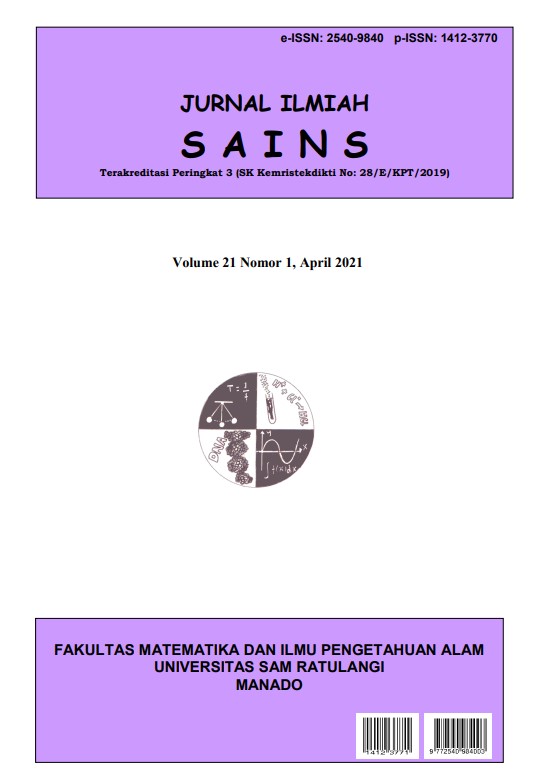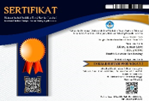Penambatan Molekuler Senyawa Bioaktif dari Ekstrak Etanol Daun Pangi (Pangium edule) Terhadap Reseptor Protease HIV-1
DOI:
https://doi.org/10.35799/jis.21.1.2021.30282Abstract
ABSTRAK
Human Immunodeficiency Virus (HIV) merupakan virus yang menyerang sistem kekebalan tubuh, dan pada akhirnya dapat menyebabkan Acquired Immune Deficiency Syndrome (AIDS). Daun Pangi (Pangium edule) yang sering digunakan sebagai sayuran oleh masyarakat di Sulawesi Utara, telah diteliti memiliki efek penghambatan pada enzim protease HIV-1. Penelitian ini bertujuan untuk mengevaluasi potensi senyawa bioaktif yang terkandung dalam daun Pangi dalam menghambat protease HIV-1 secara in silico. Senyawa ini diekstraksi menggunakan etanol dan ditentukan menggunakan Gas Chromatography-Mass Spectrometer (GC-MS). Penambatan molekul dilakukan menggunakan program Autodock Vina dengan menambatkan senyawa yang telah ditentukan pada situs aktif reseptor protease HIV-1 (PDB ID: 3NU3). Hasil GC-MS dari ekstrak etanol daun Pangi menunjukkan 12 komponen senyawa. Senyawa-senyawa ini digunakan sebagai ligan untuk ditambatkan pada protease HIV-1. Hasil penambatan senyawa-senyawa tersebut dibandingkan dengan hasil penambatan amprenavir yang digunakan sebagai ligan kontrol. Studi penambatan molekuler menunjukkan bahwa Phytol merupakan ligan dengan nilai afinitas pengikatan terendah (-8,8 kkal / mol).
Kata kunci: Pangi; penambatan molekuler; protease HIV-1
Molecular Docking of Bioactive Compounds from Pangi (Pangium edule) Leaves Ethanol Extract Against HIV-1 Protease
 ABSTRACT
Human Immunodeficiency Virus (HIV) is a virus that attacks the immune system and can eventually cause Acquired Immune Deficiency Syndrome (AIDS). The leaf of Pangi (Pangium edule), which is often used as a vegetable by people in North Sulawesi, has been investigated to have an inhibitory effect on the HIV-1 protease enzyme. This study aimed to evaluate the potential of bioactive compounds contained in Pangi leaves in inhibiting HIV-1 protease by using in silico analysis. These compounds were extracted using ethanol and determined using a Gas Chromatography-Mass Spectrometer (GC-MS). The evaluation was carried out using the Autodock Vina program by docking the determined compounds on the active site of the HIV-1 protease receptor (PDB ID: 3NU3). There were 12 compounds detected in the ethanol extract of Pangi leaves, which were then used as ligands, and the results were compared with amprenavir as a control ligand. Molecular docking study showed that Phytol was the ligand with the lowest binding affinity value ( -8.8 kcal/mol).
Keywords: Pangi; Â molecular docking; HIV-1 protease
References
Ahmed, S., A. Rakib, M. Islam, B. Khanam, F. Faiz, A. Paul, M. Chy, N. Bhuiya, M. Uddin, S. Ullah, M. Rahman, & T. Emran. 2019. In Vivo and In Vitro Pharmacological Activities of Tacca integrifolia Rhizome and Investigation of Possible Lead Compounds Against Breast Cancer Through in Silico Approaches. Clinical Phytoscience, 5(1).
Bhatti, A., M. Usman & V. Kandi. 2016. Current Scenario of HIV/AIDS, Treatment Options, and Major Challenges with Compliance to Antiretroviral Therapy. Cureus, 8(3):1–12.
Brik, A. & C. Wong. 2003. HIV-1 Protease: Mechanism and Drug Discovery. Organic and Biomolecular Chemistry, 1: 5–14.
Brooijmans, N. & I. Kuntz. 2003. Molecular Recognition and Docking Algorithms. Annual Review of Biophysics and Biomolecular Structure, 32:335–373.
Chella Perumal, P., S. Sowmya, P. Pratibha, B. Vidya, P. Anusooriya, T. Starlin, R. Vasanth, D. Jeya Sundra Sharmila & V. Gopalakrishnan. 2014. Identification of novel PPARγ Agonist from GC-MS Analysis of Ethanolic Extract of Cayratia trifolia (L.): A Computational Molecular Simulation Studies. Journal of Applied Pharmaceutical Science, 4(9): 6–11.
Chen, Y. & F. Chen. 2008. Identifying Targets for Drug Discovery Using Bioinformatics. Expert Opinion on Therapeutic Targets, 12(4): 383–389.
Earlia, N., Muslem, R. Suhendra, M. Amin, C. Prakoeswa, Khairan, & R. Idroes. 2019. GC/MS Analysis of Fatty Acids on Pliek U Oil and Its Pharmacological Study by Molecular Docking to Filaggrin as a Drug Candidate in Atopic Dermatitis Treatment. Scientific World Journal. 1–7.
Eurtivong, C., K. Choowongkomon, P. Ploypradith & S. Ruchirawat. 2019. Molecular Docking Study of Lamellarin Analogues and Identification of Potential Inhibitors of HIV-1 Integrase Strand Transfer Complex by Virtual Screening, Heliyon. 5(11): 4–11.
Fung, H.B., H. Kirschenbaum & R. Hameed. 2000. Amprenavir: A New Human Immunodeficiency Virus Type 1 Protease Inhibitor. Clinical Therapeutics, 22(5): 549–572.
Ghosh, A.K., H.L. Osswald & G. Prato. 2016. Recent Progress in the Development of HIV-1 Protease Inhibitors for the Treatment of HIV/AIDS. Journal of Medicinal Chemistry, 59(11): 5172–5208.
Głowacki, E. D., M. Irimia-Vladu, S. Bauer, & N. Sariciftci. 2013. Hydrogen-Bonds in Molecular solids-From Biological Systems To Organic Electronics. Journal of Materials Chemistry B. 1(31): 3742–3753.
Hu, Q. F., B. Zhou, J. Huang, X. Gao, L. Shu, G. Yang & C. Che. 2013. Antiviral Phenolic Compounds From Arundina gramnifolia. Journal of Natural Products. 292–296.
Hughes, P. J., E.Cretton-Scott, A. Teague & T. Wensel. 2011. Protease Inhibitors for Patients with HIV-1 Infection a Comparative Overview. In P and T, 36(6): 332-345.
Kasim, A. & W. David. 2013. Characteristic of Pangium edule Reinw as Food Preservative from Different Geographical Sites. Asia Pasific Journal of Sustainable Agriculture Food Dan Energy, 1(1): 6–9.
Kemenkes, R.I. 2014. Infodatin AIDS. Pusat Data dan Informasi Kementrian Kesehatan Republik Indonesia.
Kemenkes, R.I. 2018. Infodatin AIDS. Pusat Data dan Informasi Kementrian Kesehatan Republik Indonesia.
Kufareva, I. & R. Abagyan. 2012. Methods of protein structure comparison. Methods Mol Biol, 857:231–257.
Lipinski, C.A. 2004. Lead- and Drug-Like Compounds: The Rule-of-Five Revolution. Drug Discovery Today: Technologies, 1(4): 337–341.
Lv, Z., Y. Chu & Y. Wang. 2015. HIV Protease Inhibitors: A Review of Molecular Selectivity and Toxicity. HIV/AIDS - Research and Palliative Care, 7: 95–104.
Mapanawang, A. L. & H. Elim. 2019. Pangi Leaf (Pangium edule Reinw) Herbal Medicine: A Marvelous Candidate for the Prominent HIV Herbal Medicine. Science Nature, 2(2): 97–104.
Membalik, V., Y. George, A. Rahman & A. Asman. 2018. Antifungal Activities of Pangium edule Reinhw Seed Extracts Inhibts The Growth of Aspergillus flavus, Producer of Aflatoxinx, Through The In-Vitro Test. International Journal Of Pharmaceutical Sciences And Research, 10(6): 2718–2722.
Morris, G., R. Huey, W. Lindstrom, M. Sanner, Belew, K. Ri, D. Goodsell & A. Olson. 2009. AutoDock4 and AutoDockTools4: Automated Docking with Selective Receptor Flexibility. Journal of Computational Chemistry, 30(16): 2785–2791.
O’Boyle, N. M., M. Banck, C. James, C. Morley, T. Vandermeersch & G. Hutchison. 2011. Open Babel: An Open Chemical Toolbox. Journal of Cheminformatics, 3(33): 1–14.
Pandey, D., U. Chouhan & N. Verma. 2017. HIV Infection: A Review of Their Inhibitors Progression. Biomedical and Pharmacology Journal, 10(2): 749–758.
Patick, A.K. & K. Potts. 1998. Protease Inhibitors as Antiviral Agents. Clinical Microbiology Reviews, 11(4): 614–627.
Rahmad, R., N. Earlia, C. Nabila, L. Inayati, M. Amin, C. Prakoeswa, K. Khairan & R. Idroes. 2019. Antibacterial Cream Formulation of Ethanolic Pliek U Extracts and Ethanolic Residue Hexane Pliek U Extracts Against Staphylococcus aureus. IOP Conference Series: Materials Science and Engineering.
Rakib, A., A. Paul, N. Chy, S. Sami, S. Baral, M. Majumder, A. Tareq, M. Amin, A. Shariar, M. Uddin, M. Dulta, T. Tallei, T. Bin Emran & J. Simal-Gandara. 2020. Biochemical and Computational Approach of Selected Phytocompounds from Tinospora crispa in the Management of COVID-19. Molecules, 25: 1–16.
Rakib, A., S. Sami, N. Mimi, M. Chowdhury, T. Eva, F. Nainu, A. Paul, A. Shahriar, A. Tareq, N. Emon, S. Chakraborty, S. Shil, S. Mily, T. Hadda, F. Almalki & T. Bin Emran. 2020.
Immunoinformatics-Guided Design of an Epitope-Based Vaccine Against Severe Acute Respiratory Syndrome Coronavirus 2 Spike Glycoprotein. Computers in Biology and Medicine. 124.
Razzaghi-Asl, N., S. Sepehri, A. Ebadi, R. Miri & S. Shahabipoura. 2015. Effect of Biomolecular Conformation on Docking Simulation: A Case Study on A Potent HIV-1 Protease Inhibitor. Iranian Journal of Pharmaceutical Research. 14(3): 785–802.
Sadler, B. M., C. Hanson, G. Chittick, W. Symonds & N. Roskell. 1999. Safety and Pharmacokinetics of Amprenavir (141W94), a Human Immunodeficiency Virus (HIV) Type 1 Protease Inhibitor, Following Oral Administration of Single Doses to HIV-Infected Adults. Antimicrobial Agents and Chemotherapy, 43(7): 1686–1692.
Sillapachaiyaporn, C. & S. Chuchawankul. 2019. HIV-1 Protease and Reverse Transcriptase Inhibition by Tiger Milk Mushroom (Lignosus rhinocerus) Sclerotium Extracts: In vitro and In Silico Studies. Journal of Traditional and Complementary Medicine. 4–12.
Singh, S., A. Gupta & A. Verma. 2013. Molecular Properties and Bioactivity Score of The Aloe vera Antioxidant Compounds - in Order to Lead Fnding. Research Journal of Pharmaceutical, Biological and Chemical Sciences, 4(2): 876–881.
Tallei, T.E., S. Tumilaar, N. Niode, Fatimawali, B. Kepel, R. Idroes & Y. Effendi. 2020. Potential of Plant Bioactive Compounds as SARS-CoV-2 Main Protease (Mpro) and Spike (S) Glycoprotein Inhibitors: A Molecular Docking Study. Preprints. 1–18.
Trott, O. & A. Olson. 2009. AutoDock Vina: Improving the Speed and Accuracy of Docking with A New Scoring Function, Efficient Optimization, and Multithreading. Journal of Computational Chemistry, 31(2): 455–461.
Vijayan, K.V., K.P. Karthigeyan, S.P. Tripathi, & L.E. Hanna. 2017. Pathophysiology of CD4+ T-Cell Depletion in HIV-1 and HIV-2 Infections. Frontiers in Immunology, 8: 1–8.
Volkamer, A., D. Kuhn, F. Rippmann & M. Rarey. 2012. Dogsitescorer: A Web Server for Automatic Binding Site Prediction, Analysis and Druggability Assessment. Bioinformatics, 28(15): 2074–2075.
Yanuar, A., H. Suhartanto, A. Mun’im, B. Nugraha & R. Syahdi. 2014. Virtual Screening of Indonesian Herbal Database as HIV-1 Reverse Transcriptase Inhibitor. Bioinformation, 8(24): 1206–1210.
Yilmaz, N., R. Swanstrom & C. Schiffer. 2016. Improving Viral Protease Inhibitors to Counter Drug Resistance. Trends in Microbiology, 24(7): 547–557.
Zhang, S., A.H. Kaplan & A. Tropsha. 2011. HIV-1 Protease Function and Structure Studies with The Simplicial Neighborhood Analysis of Protein Packing Method. Proteins Structure Function Genetics, 73(3):742–53.
Zubair, M.S., S. Anam, A. Khumaidi, Y. Susanto, M. Hidayat & A. Ridhay. 2016. Molecular Docking Approach to Identify Potential Anticancer Compounds from Begonia (Begonia sp). Advances of Science and Technology for Society. 1-7.







